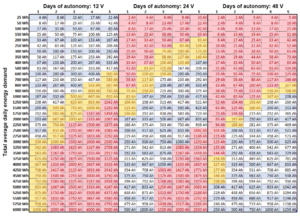Simplified energy storage sizing and selection
The energy storage system is sized based upon the average daily energy requirements for the system. The preliminary steps of this process output a suggest Ah size for the energy storage system, but then it is necessary to determine a series and parallel configuration based upon the available battery voltages and sizes.
Assumptions:
- Lead acid batteries are used.
- Batteries will be discharged to 50% depth of dischrage.
Step 1: Determine days of autonomy parameter
The days of autonomy parameter determines the number of days that the system will be able to meet energy needs without additional charging. 1 day of autonomy provides enough energy storage capacity to provide energy for the loads from the load evaluation for 1 day without any additional charging. Each additional day adds an additional day of energy storage capacity. For example:
- 205 Ah lead acid battery x 1 day of autonomy = 205 Ah
- 205 Ah lead acid battery x 2 days of autonomy = 410 Ah
- 205 Ah lead acid battery x 3 days of autonomy = 615 Ah
The value that is chosen for this parameter depends largely upon the variability of the solar resource, the intended use of the system, and the budget. It is almost always preferable to have additional storage, therefore budget often becomes the primary constraint. There are various considerations that go into determining the value that is appropriate for a particular design:
- If a system is intended for a location where the weather or solar resource is highly variable, the value for days of autonomy should be increased.
- If a system is intended to provide power at a location where the users will adjust their energy consumption according to the weather or that is used infrequently, fewer days of autonomy can be built into the system. A value of 2 days of autonomy may be appropriate in these cases as long as there is a sufficiently sized PV source or an additional form of generation.
- If a system is intended to provide power at a location that must operate continually, like at a health clinic, it is recommended that a significant number of days of autonomy are built into the system or that an additional form of generation, like a generator, is added to the system. An energy storage system with 5-7 days of autonomy for a health clinic will often be quite substantial in size, difficult to charge properly, and costly. Therefore, a backup generator should be considered in this case.
- The days of autonomy value that is chosen will be used to size the energy storage system to meet energy demand when the battery bank is new, but the storage capacity of the energy storage system will gradually decline over time. Therefore, oversizing a battery bank to take this into account is a good idea.
Step 2: Determine minimum Ah required Using the chart below, determine the minimum Ah required based upon the DC system voltage and the Total average daily energy demand. Cells highlighted in red are not recommended configurations - a higher or lower DC system voltage should be used. Cells highlighted in yellow situations are questionable configurations - a higher or lower DC system voltage should be considered. These recommendations are based upon commonly available battery sizes, equipment availability, and the recommendation that the number of parallel strings of batteries does not exceed 3.
Step 5: Calculate number of batteries in series
Lead acid batteries are commonly available in 2V, 4V, 6V, 12V designs that can be wired in series to achieve a 12V, 24V, or 48V system voltage. See Battery wiring for more information on how to properly configure a battery bank. With small systems 12V batteries are the standard, but as system size increases lower battery voltages lead to more storage with fewer parallel strings, which is a better design. Deep cycle batteries with voltages below 12V can be difficult to find in some locations.
| Batteries in series | = DC system voltage ÷ Chosen battery voltage |
|---|
Step 6: Calculate number of parallel battery circuits
Lead acid batteries are available in a variety of Ah ratings. They can be wired in parallel to achieve the desired total Ah of storage for the system. See Battery wiring for more information on how to properly configure a battery bank. The result of this calculation should be rounded up, meaning that if the number of parallel strings is more than 1, then 2 parallel strings are required. The other option would be to use a battery with a higher Ah rating.
| Number of parallel battery circuits | = Total Ah required (Step 4) ÷ Chosen battery Ah rating |
|---|
Step 7: Calculate final Ah capacity
The final Ah capacity of the battery bank is the chosen battery Ah rating multiplied by the number of parallel strings. This value is important for other calculations in the design process.
| Final Ah capacity | = Number of parallel battery circuits (Step 6) × Chosen battery Ah rating |
|---|

